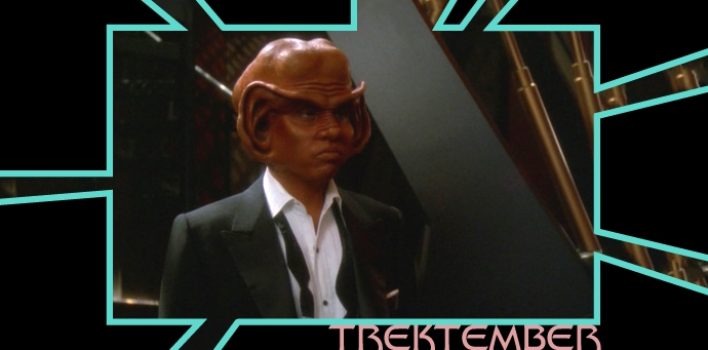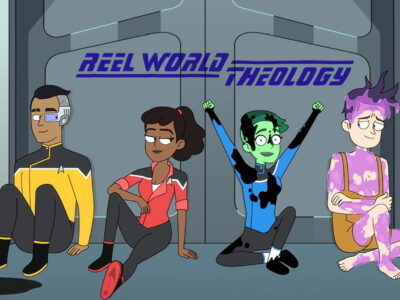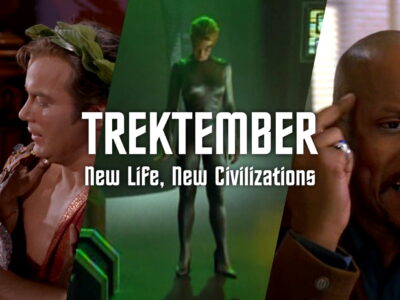Trektember: It’s Only a Paper Moon
Thanks to my gift of procrastination, I am writing this piece just days after the death of Aron Eisenberg, discussing reflections of the Divine in probably his greatest performance in by far his most well-known role, Nog. Read my tribute to Aron here.
On my own blog, I discussed the collision of fantasy and reality in this episode, juxtaposed with the same theme in the last episode I wrote about, “Far Beyond the Stars.” Here, I’d like to explore a different, perhaps deeper theme in the episode: what it means to have a soul.
I’ve discussed how Star Trek deals with the concept of the soul through things like the Vulcan katra, the transporter, and other elements many times. (Watch my talk, “Matter Stream: Star Trek and the Soul” here.) In this episode, however, I was confronted with more than just the concept of a living spirit, a non-corporeal “something moreness” that might persist beyond the bounds of physical death. Instead, I was met with the challenge of what it costs to have and keep a soul and how we may be able to lose our “soulishness,” even as we live.
“I never took the time,” the lyrics to PlankEye’s song “Goodbye” say, “to stop and realize that death takes many forms, even while alive.” Nog didn’t die on the battlefield. He was one of the “lucky ones.” He only lost a leg. And, in the world of 24th century medicine, he was quickly engrafted with a brand new, biosynthetic leg that “works perfectly.” So he should be fine, right? What a miracle to live in a time when you can lose a leg and, well…not lose a leg! He should be happy, dancing about like a paralytic lifted from his mat by a traveling Galilean mystic.
But he’s not. According to Ezri, Nog has been “under constant psychiatric care for almost two months now,” and he’s miserable. Talking about his feelings, as Nog puts it, isn’t helping. In fact, it may be making things worse. He is, in his own words, “a little sick of it.” And there’s another thing. His leg hurts. His brand new, fully functional leg which is, according to medical scans, absolutely not sending any pain signals to his brain, hurts. While other amputees might deal with an itch felt on a phantom limb, Nog feels a pain that is both in his very real leg and, according to the experts, entirely unreal and in his head. It’s a phantom feeling in an extant limb.
So many of us who deal with emotional pain and psychological trauma are treated as though our pain isn’t real. “It’s all in your head,” we’re told. “Get over it.” “Suck it up and move on.” “It’s not like your leg was cut off. You’re fine!” But Nog is not fine. And his leg actually was cut off, for the record, so there’s that. But this idea that emotional injuries are not “real” injuries is the dangerous mindset that makes us so insensitive to the mentally ill and that causes people to stay with abusive spouses because, “at least they’re not hitting me.”
Such thinking is toxic because our interior selves are as real and as important as our exterior selves. In fact, they are perhaps the most real thing about us. Like the Velveteen Rabbit, who only becomes “real” after being worn and tattered with years of love and all the unsafe conditions that come with it, so we do not become real until we have opened ourselves to the risks of life that may bruise our egos and skin our knees, but ultimately shape our souls.
“You stay here you’re going to die,” Vic tells Nog. “Not all at once, but little by little. Eventually, you’ll become as hollow as I am.” Nog retorts, “You don’t seem hollow to me.” “Compared to you,” Vic says, “I’m hollow as a snare drum.” That hollowness, that spiritual death to which Vic refers can creep into our own lives and hearts when we choose self-preservation, escape, and retreat over a full, robust engagement with life itself, in all its pain and chaos, and it all its sweetness and beauty.
“You can’t selectively numb feelings,” says Jonathan van Ness, drawing on Brene Brown, “So if you numb the vulnerability, you also numb joy, happiness, connection. You can’t have connection and joy and happiness without vulnerability.” The human soul isn’t just what “goes to Heaven when we die.” It’s how we remain more than just alive, here and now. And the cost of having a soul is risk, pain, uncertainty, chaos, and fear—fear which can only be overcome by love.
Having a soul doesn’t mean living “the blessed life” or being high on the mountaintop. It means that when we are blessed, we cherish our blessings because we have been in want. It means that when we reach the mountaintop, we’ve earned it because we climbed the whole way and have come to realize that God was just as present with us—perhaps even more so—in the darkness of the deepest valley of defeat and death as on the peak of victory and life.
In fact, there is no life without struggle. And struggle hurts. Pain lasts. Trauma is real. In this world, Jesus tells us, we will have trouble. But we can take heart because Christ has overcome the struggles of this world. And if the Spirit of the Living Jesus abides also in us (and it does), then we can overcome too. Not necessarily in spectacular fashion. Not all at once, to be sure. But often little by little, in the small but amazing miracle of getting up yet another morning, of leaning on our canes a little less, of taking the risk of telling another human being, despite every objection that may come against us, “My leg hurts,” until someone listens and loves us enough to acknowledge that our pain is real.
As Nog finally exits the holosuite and walks into Quark’s bar without his cane, Leeta asks, “Are you okay?” “No,” Nog replies, “but I will be.” As the old Christian saying goes, “I have been saved; I am being saved; I will be saved.” It’s the “already, not yet” of salvation. Not because God is stingy with Grace, Mercy, and Love. Not because we must earn or live up to the calling God has for us, but because the love of God is boundless and grants us both the struggle and the strength to truly have a soul, to be, in Roddenberry’s words, “a legitimate part of all that is.”
We come to that reality, not by hiding and embracing fear, but by risking hurt and embracing love. Like Nog, when we get hurt, we may need to retreat for a time. Interior wounds, wounds of the heart, are real. But there comes a time when we must emerge from the holosuite and have the courage to say, “I’m not okay. But I will be.”
With Love and Gratitude for Aron Eisenberg, January 6, 1969 – September 21, 2019








Pingback: Trektember: What You Leave Behind | Reel World Theology